Corsica: ‘The Island Of Statue-Menhirs’ – Where Humans Lived At Least 7,000 BC
A. Sutherland - AncientPages.com - On Corsica - 'the island of statue-menhirs' - human habitation began at least 7000 BC. The island is home to remarkable granite figures—some 13 feet tall and weighing up to two and a half tons. It's truly an awe-inspiring sight.
With around 80 menhirs, Corsica stands out from other Mediterranean countries with megalithic sites. Most of these menhirs primarily represent dead heroes, warriors, and chieftains.
Spread over a beautiful area of Filitosa and Stantari, they are among the oldest monumental statues in Europe and have been known to natives for as long as anyone can remember.
The echoes of a grand megalithic era persist predominantly through the Corsican death rituals, which hold significant sway in the customs of this age-old society, especially within rural communities. This enduring tradition has withstood even the Catholic Church's efforts to infuse Christianity into the island.
The surviving dolmens show that they were designed for collective burial. Statues were discovered by Prosper Merimée, French historian, novelist, and archaeologist, during his survey of the island in 1830. This fascinating legacy of huge stone monuments was left by the indigenous megalithic culture that inhabited Corsica millennia ago and flourished until 1400 BC.
 Picture of several millennia old stones at Filitosa, south of Corsica, France. Image credit: Image credit: Braucher - CC BY-SA 4.0 DEED
Picture of several millennia old stones at Filitosa, south of Corsica, France. Image credit: Image credit: Braucher - CC BY-SA 4.0 DEED
The origin of the name Corsica is often debated and remains a mystery, and the most pre-dawn time of the island is an unknown page in the history of Europe.
The stone figures in Corsica are uniquely aligned, but they do not align with any known astronomical patterns based on the sun's or moon's movements. Instead, they follow a north-south direction. This peculiar alignment remains a mystery even today, adding to their intriguing appeal.
People have always been fascinated by megalithic monuments, and standing megaliths have been unearthed on every continent. However, only a few of them have clearly defined anthropomorphic features. The Corsican granite monuments represent one of the best examples.

Left: Anthropomorphic menhir in Tavera, Corsica. Image source - CC BY-SA 3.0: Right: Statue-Menhir of Tavera. Image credit: Asanotori - CC BY-SA 4.0
During an archaeological expedition in 1954, French archaeologist Roger Grosjean discovered a 160-ft high hill with 17 sculptured menhirs in the south of Corsica, at Filitosa, today's most celebrated prehistoric site. Later, Grosjean unearthed many more of them, even those depicting daggers and swords of an unusual design.
According to him, Corsica's carved figures may represent the warriors, the enemy chiefs defeated in war by the so-called Torréens, "torre builders" from the eastern Mediterranean who landed on Corsica about 1500 BC.
"For the origin of sculpture, these monumental figures are as important as the cave drawings of Lascaux and Altamira are for the origin of painting. When you look at one, you know it represents someone—someone to whom you could give a name," according to Grosjean.
One of Grosjean's theories suggests that they were the Torréens (Torreans ) or "Sea People" ("People of the Sea"), mysterious Mediterranean seafarers who were depicted on the Corsican monuments. Those seafarers and destructive warriors invaded neighboring cultures like Syria, Palestine, Cyprus, eastern Anatolia, and Egypt in the 2nd millennium BC.
They built dome-shaped temples in Corsica, Sardinia, and other places in the Mediterranean.
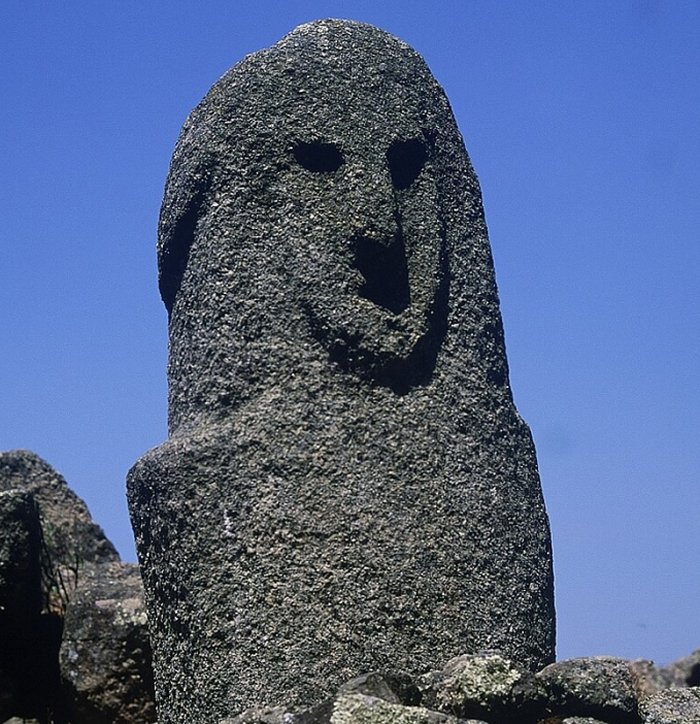
Filitosa IX, a menhir statue in Filitosa (Corse-du-Sud, France). Image credit: Blejuez - CC BY-SA 3.0 DEED
Some ancient records say the Torréens destroyed many sculptures using their parts to construct their fortresses. According to other theories, they are representations of humans or superhuman figures. Myths of various cultures worldwide widely support this point of view.
The Greek legend tells about Deucalion and Pyrrha, who, after the Flood, threw stones behind their backs and saw them turn into men and women to repopulate the planet.
Corsica has been occupied continuously since the Mesolithic era. Even after the Greek and Roman invasions, Corsicans continued to worship the figures. Even today, the inhabitants of this mysterious island are very proud of the enigmatic aspect of their history.
Written by – A. Sutherland AncientPages.com Staff Writer
Copyright © AncientPages.com All rights reserved. This material may not be published, broadcast, rewritten or redistributed in whole or part without the express written permission of AncientPages.com
Expand for referencesReferences:
O'Carroll O, Atkinson D. Corsica
D. Facaros, M. Pauls, Corsica
More From Ancient Pages
-
 Saptarishi – Seven Sages Who Guided Humanity During Four Great Ages
Featured Stories | Apr 2, 2019
Saptarishi – Seven Sages Who Guided Humanity During Four Great Ages
Featured Stories | Apr 2, 2019 -
 Ancient People Dressed Baby Boys In Blue To Ward Off Evil Spirits
Ancient History Facts | Mar 5, 2019
Ancient People Dressed Baby Boys In Blue To Ward Off Evil Spirits
Ancient History Facts | Mar 5, 2019 -
 Canopic Jars: Funerary Tradition Of Ancient Egyptians And Their Beliefs In Afterlife
Ancient Traditions And Customs | Jun 23, 2017
Canopic Jars: Funerary Tradition Of Ancient Egyptians And Their Beliefs In Afterlife
Ancient Traditions And Customs | Jun 23, 2017 -
 Mystery Of The Medieval ‘Out Of Time’ Village In England
Featured Stories | Mar 21, 2024
Mystery Of The Medieval ‘Out Of Time’ Village In England
Featured Stories | Mar 21, 2024 -
 Were Medieval Philosophers Familiar With The Multiverse Theory?
Featured Stories | Oct 4, 2018
Were Medieval Philosophers Familiar With The Multiverse Theory?
Featured Stories | Oct 4, 2018 -
 Towering Sacred Mt. Fuji: Abode Of The Immortals In Ancient Japanese Beliefs
Featured Stories | Feb 23, 2017
Towering Sacred Mt. Fuji: Abode Of The Immortals In Ancient Japanese Beliefs
Featured Stories | Feb 23, 2017 -
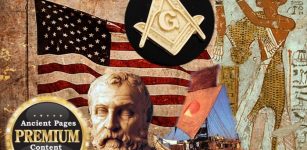 Freemasons Secrets – American Democracy Is Part Of An Ancient Universal Plan – Egyptian Temple And Legendary Expedition Hold The Clues – Part 2
Ancient Mysteries | Jul 13, 2018
Freemasons Secrets – American Democracy Is Part Of An Ancient Universal Plan – Egyptian Temple And Legendary Expedition Hold The Clues – Part 2
Ancient Mysteries | Jul 13, 2018 -
 Mystery Of Saint Brendan’s Island – Glimpses From An Alternate Reality, Fata Morgana Or A Submerged Land?
Featured Stories | May 6, 2023
Mystery Of Saint Brendan’s Island – Glimpses From An Alternate Reality, Fata Morgana Or A Submerged Land?
Featured Stories | May 6, 2023 -
 Tages: Etruscan Prophet Who Revealed Sacred Knowledge Before He Vanished
Featured Stories | Mar 1, 2016
Tages: Etruscan Prophet Who Revealed Sacred Knowledge Before He Vanished
Featured Stories | Mar 1, 2016 -
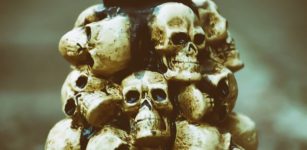 Day Of The Dead: From Aztec Goddess Worship To Modern Mexican Celebration
Ancient Traditions And Customs | Oct 30, 2019
Day Of The Dead: From Aztec Goddess Worship To Modern Mexican Celebration
Ancient Traditions And Customs | Oct 30, 2019 -
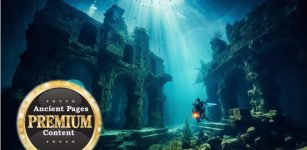 Diver Says He Found Mysterious Underwater Ancient Tomb, Ruins And Artifacts Of An Unknown Advanced Civilization
Featured Stories | Oct 10, 2023
Diver Says He Found Mysterious Underwater Ancient Tomb, Ruins And Artifacts Of An Unknown Advanced Civilization
Featured Stories | Oct 10, 2023 -
 Secrets Of Mona’s Caves: Rock Art Reveals Ancient People Were Ahead Of Their Time Long Before The Arrival Of Columbus
Archaeology | Nov 4, 2017
Secrets Of Mona’s Caves: Rock Art Reveals Ancient People Were Ahead Of Their Time Long Before The Arrival Of Columbus
Archaeology | Nov 4, 2017 -
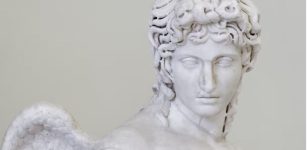 Spells, Charms, Erotic Dolls: Love Magic In The Ancient Mediterranean
Featured Stories | Oct 24, 2022
Spells, Charms, Erotic Dolls: Love Magic In The Ancient Mediterranean
Featured Stories | Oct 24, 2022 -
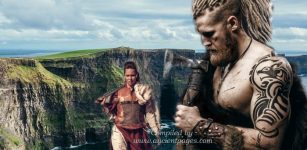 Vikings’ Legacy Is Still Alive In Ireland – DNA, Ancient Ruins And Modern Cites Reveal
Civilizations | May 22, 2021
Vikings’ Legacy Is Still Alive In Ireland – DNA, Ancient Ruins And Modern Cites Reveal
Civilizations | May 22, 2021 -
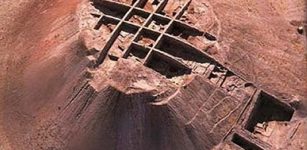 Norsuntepe – Little-Known Mysterious Prehistoric Site In Anatolia, Turkey: Why Was It Abandoned And Destroyed By Fire?
Civilizations | Mar 13, 2014
Norsuntepe – Little-Known Mysterious Prehistoric Site In Anatolia, Turkey: Why Was It Abandoned And Destroyed By Fire?
Civilizations | Mar 13, 2014 -
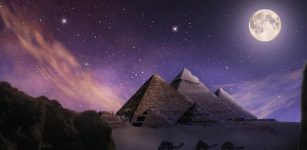 Connection Between Alpha Draconis And Egyptians Pyramids Revealed
Archaeology | Jan 12, 2020
Connection Between Alpha Draconis And Egyptians Pyramids Revealed
Archaeology | Jan 12, 2020 -
 Ancient Mesopotamian City Discovered And Identified As Xarab-i Kilashin
Archaeology | Jul 11, 2017
Ancient Mesopotamian City Discovered And Identified As Xarab-i Kilashin
Archaeology | Jul 11, 2017 -
 Enigmatic Stones Of The Picts: Orkney’s Unique Stone With Dragon-Like Creature And Cross Carving
Civilizations | Oct 19, 2018
Enigmatic Stones Of The Picts: Orkney’s Unique Stone With Dragon-Like Creature And Cross Carving
Civilizations | Oct 19, 2018 -
 Controversial Artifact Fuente Magna Could Re-Write Ancient History – America’s Mysterious Rosetta Stone
Artifacts | Oct 18, 2014
Controversial Artifact Fuente Magna Could Re-Write Ancient History – America’s Mysterious Rosetta Stone
Artifacts | Oct 18, 2014 -
 Ancient Mysteries And Curious Legends Of Chimney Rock And Grandfather Mountain In North Carolina
Featured Stories | Feb 5, 2024
Ancient Mysteries And Curious Legends Of Chimney Rock And Grandfather Mountain In North Carolina
Featured Stories | Feb 5, 2024

